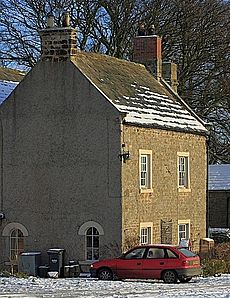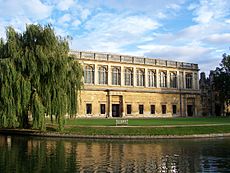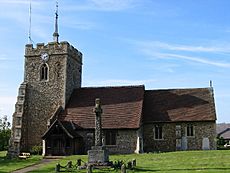William Lax facts for kids
Quick facts for kids
William Lax
|
|
|---|---|
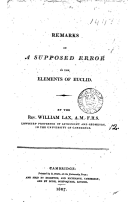
Cover of Remarks on a Supposed Error in the Elements of Euclid
|
|
| Born | 1761 Ravensworth, North Riding of Yorkshire, England
|
| Died | 29 October 1836 (aged 74–75) St Ippolyts, Hertfordshire, England
|
| Alma mater | Trinity College, Cambridge |
| Known for | Remarks on a Supposed Error in the Elements of Euclid Tables to be Used with the Nautical Almanac |
| Relatives | Andrew Amos (son-in-law) |
| Awards | Smith's Prize |
| Scientific career | |
| Fields | Astronomy, mathematics |
| Institutions | University of Cambridge Board of Longitude Fellow of the Royal Society |
William Lax (1761 – 29 October 1836) was an English astronomer and mathematician. He was a professor at the University of Cambridge for 41 years. He was also a member of the Royal Society, a group for important scientists.
Lax was born in Ravensworth, England. He studied at Trinity College, Cambridge, and was a top student in math. He became a minister and later set up his own observatory (a place to study stars).
He was known for his book Remarks on a Supposed Error in the Elements of Euclid (1807). He also worked on the Nautical Almanac, a guide that helped sailors navigate. People said that whatever Lax studied, he became an expert in it.
Contents
William Lax's Early Life and Education
William Lax was born in 1761 in the village of Ravensworth, England. His parents were William and Hannah Lax. He was educated at the Kirby Ravensworth Free Grammar School. There, he learned Latin, Greek, English language, and math.
At 19, Lax went to Trinity College, Cambridge, in 1780. Trinity was a very rich college at the time. He was a "sizar," which meant he paid lower fees. In return, he helped out at the college. By the 1700s, sizars were treated like other students.
In 1784, Lax earned a scholarship at Trinity. He became a private tutor to John Pond, who later became the Astronomer Royal. In 1785, Lax earned his Bachelor of Arts (B.A.) degree. He was the top math student in his year, called the Senior Wrangler. He also won the first Smith's Prize.
William Lax's Career and Achievements
Becoming a Professor
In 1785, Lax started working as a curate (a type of minister) in Tideswell. In 1786, he became a fellow of Trinity College. This was a common honor for top students. He became a minister in 1787 and earned his Master of Arts (M.A.) degree in 1788.
From 1789 to 1791, he helped lead oral exams for students. In 1791, he was appointed as a tax collector for the University. He worked as an assistant tutor until 1801. He left this job when he married Margaret Cradock. College fellows were not allowed to be married at that time.
Lowndean Professor of Astronomy
In 1795, Lax became the Lowndean Professor of Astronomy and Geometry. This was a special job at Cambridge. It paid well, and the main duty was to examine students for the Smith's Prize. He held this position for 41 years.
During his time, math was very important at Cambridge. Lax was part of the "Cambridge traditionalists." They taught math based on Isaac Newton's ideas. However, new French math ideas were becoming popular. Lax and others were not happy about these changes.
Lax was criticized because he did not give lectures. The rules of his professorship said he should give 40 lectures each year. But his predecessor (the person before him) also did not give lectures. Later, it became more important for professors to teach.
Member of the Royal Society
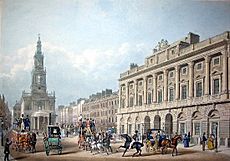
Lax became a Fellow of the Royal Society in 1796. This is a very respected group for scientists. He was nominated by important people like the Astronomer Royal, Nevil Maskelyne.
Lax wrote two important papers for the Royal Society:
- In 1799, he wrote about "A Method of finding the Latitude of a place." This paper helped sailors find their location.
- In 1809, he wrote "On A Method of Examining the Divisions of Astronomical Instruments." This paper discussed how to check if scientific tools were accurate.
In 1807, Lax wrote Remarks on a Supposed Error in the Elements of Euclid. In this book, he defended the ancient Greek mathematician Euclid. Lax believed Euclid's work was a great achievement for human intelligence.
Work with the Board of Longitude
Lax joined the Board of Longitude in 1795. This government group offered prizes to people who could solve the problem of finding longitude at sea. Finding longitude was very important for accurate navigation.
In 1821, the Board published Lax's tables. These tables helped sailors find latitude and longitude using the Nautical Almanac. The Board gave Lax £1050 for his work. However, new, very accurate clocks called chronometers became available. These made Lax's tables less necessary.
Lax attended many meetings of the Board of Longitude. He was one of the most active members. In 1828, he added a method for correcting lunar distances to the Nautical Almanac. The Board was dissolved in 1828. Lax tried to get it restarted, but he was not successful. A new edition of his tables was published after his death. His work was considered valuable for navigation.
William Lax's Personal Life
In 1801, Lax became a vicar (a type of minister) in Marsworth and St Ippolyts. He moved to St Ippolyts and built a private observatory there. He even moved parts of an observatory that once belonged to Isaac Newton. His observatory was one of the 20 most notable private observatories in England.
Lax spent the last 30 years of his life studying astronomy. When he arrived at St Ippolyts, he planted trees in the shape of his initials, "W L." He also created a park with a lake for ice skating in winter.
In September 1801, he married Margaret Cradock. She was the daughter of Sheldon Cradock, who owned the land in Lax's home village. Lax was friends with many important scientists and supported their work. He also supported the Whig political party.
His brother, Thomas Lax, was a farmer. He was known for breeding excellent shorthorn cattle. He was also a local police chief.
William Lax's Death
William Lax's health became weak in his later years. He died suddenly on October 29, 1836, at his home in St Ippolyts. His obituary said that his body was not as strong as his active mind. It also said he was a "most excellent and amiable man."
He left behind his wife and two daughters, Margaret and Marian. His daughter Margaret married Andrew Amos. Through this family line, William Lax is the grandfather of Sheldon Amos and the great-grandfather of Maurice Amos. They were part of a famous family of lawyers.


